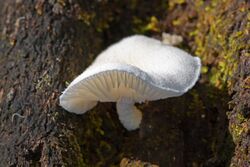Biology:Physalacriaceae
| Physalacriaceae | |
|---|---|

| |
| Oudemansiella australis | |
| Scientific classification | |
| Domain: | Eukaryota |
| Kingdom: | Fungi |
| Division: | Basidiomycota |
| Class: | Agaricomycetes |
| Order: | Agaricales |
| Family: | Physalacriaceae Corner (1970) |
| Type genus | |
| Physalacria Peck (1882)
| |
The Physalacriaceae are a family of fungi in the order Agaricales. Species in the family have a widespread distribution, ranging from the Arctic, (Rhizomarasmius), to the tropics, e.g. Gloiocephala, and from marine sites (Mycaureola) and fresh waters (Gloiocephala) to semiarid forests (Xerula).
Description
Most species in the Physalacriaceae form fruit bodies with caps and stipes. They have a monomitic hyphal system (wherein only generative hypha are produced), and clamp connections are present in the hyphae. Basidia (spore-bearing cells) are club-shaped with two to four sterigmata. The basidiospores generally have ellipsoidal, spindle-like (fusiform), cylindrical, or tear-drop (lacrimiform) shapes; they are thin-walled, hyaline, and do not react with Melzer's reagent.[1] The family also contains corticioid fungi (in genus Cylindrobasidium) and a secotioid species (Guyanagaster necrorhiza).[2]
Taxonomy
The family was originally defined by English mycologist E.J.H. Corner in 1970[3] and revised in 1985 by Jacques Berthier[4] but neither author anticipated the application to a molecularly defined group of agarics first identified by Moncalvo and others in 2002.[5] Molecular studies placed Physalacria, formerly the sole genus in this family, together with the agaric genera Flammulina and Xerula and Armillaria. Due to the precedence rules based on date of publication, the family name "Physalacriaceae" became applicable for all these fungi, making the former family "Xerulaceae" obsolete.[5][6][7][8]
Genera
See also
References
- ↑ Fungal Families of the World. Wallingford, UK: CAB International. 2007. pp. 277–8. ISBN 978-0-85199-827-5.
- ↑ "Guyanagaster, a new wood-decaying sequestrate genus of Agaricales from the Guiana Shield". American Journal of Botany 97 (9): 1474–84. 2010. doi:10.3732/ajb.1000097. PMID 21616901. https://dukespace.lib.duke.edu/dspace/bitstream/10161/4195/1/281539000007.pdf.
- ↑ Corner EJH (1970). Supplement to 'A monograph of Clavaria and allied genera'. Beihefte zur Nova Hedwigia. 33. Lehre, Germany: J. Cramer. p. 10.
- ↑ Berthier J. (1985) (in fr). Les Physalacriaceae Du Globe: (Hyménomycétales clavarioïdes). Bibliotheca Mycologica. 98. Lubrecht & Cramer. ISBN 978-3768214247.
- ↑ 5.0 5.1 "One hundred and seventeen clades of euagarics". Molecular Phylogenetics and Evolution 23 (3): 357–400. 2002. doi:10.1016/S1055-7903(02)00027-1. PMID 12099793.
- ↑ "Reconstructing the Clavariaceae using nuclear large subunit rDNA sequences and a new genus segregated from Clavaria". Mycologia 98 (5): 746–62. 2006. doi:10.3852/mycologia.98.5.746. PMID 17256578.
- ↑ "Phylogenetic relationships in the gymnopoid and marasmioid fungi (Basidiomycetes, euagarics clade)". Mycologia 97 (3): 667–79. 2005. doi:10.1080/15572536.2006.11832797. PMID 16392255.
- ↑ "Cibaomyces, a new genus of Physalacriaceae from East Asia". Phytotaxa 162 (4): 198–210. 2014. doi:10.11646/phytotaxa.162.4.2.
- ↑ 9.0 9.1 Moreau, P.-A.; Vila, J.; Aime, M.C.; Antonín, V.; Horak, E.; Pérez-Butrón, J.L.; Richard, F.; Urban, A. et al. (2015). "Cibaomyces and Cyptotrama, two new genera for Europe, and an emendation of Rhizomarasmius (Basidiomycota, Physalacriaceae).". Mycol. Progress 14 (2). doi:10.1007/s11557-015-1024-4.
- ↑ "Paraxerula ellipsospora, a new Asian species of Physalacriaceae". Mycological Progress 13 (3): 639–47. 2014. doi:10.1007/s11557-013-0946-y.
External links
- "Physalacriaceae Corner". Atlas of Living Australia. https://bie.ala.org.au/species/urn:lsid:indexfungorum.org:names:81165.
Wikidata ☰ Q3041113 entry
 |

